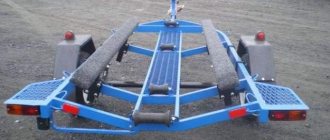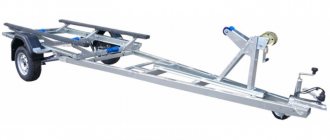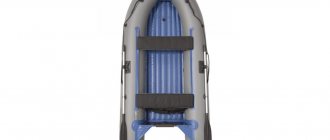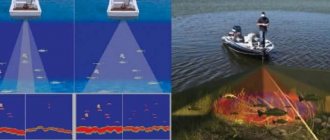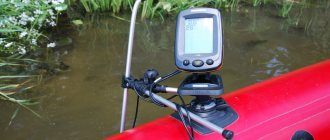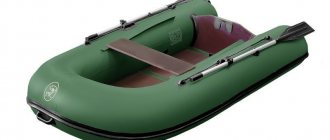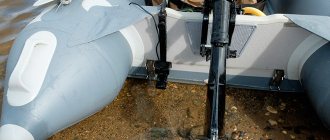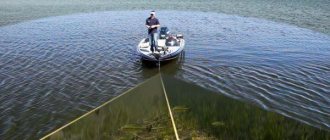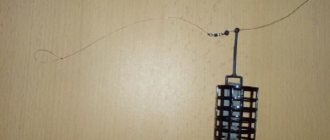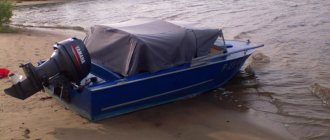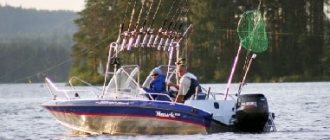In this article we will look at how to choose a trailer for transporting a boat, what you need to know and what to look for when choosing a trailer for watercraft.
Let me make a reservation right away: I don’t have a boat or a cutter, but I have sold a sufficient number of trailers for watercraft, and I have had feedback from most of the buyers. In addition, next door to us there was an organization that repaired boats, boats, jet skis, motors for them, etc. And communication with the head of this organization also gave me enough knowledge to understand how to choose the right trailer for transporting a boat.
I will not repeat here general information on choosing trailers; it can be found in another article. Here I will only talk about the nuances that will help you choose a trailer for transporting water equipment.
How to decide on the size
So, in order... Of course, to choose a trailer for transporting a boat, you need to know the size and weight of the boat itself. Agree. This is a truism. But how, knowing the size of the boat, can you avoid making a mistake with the size of the trailer? After all, if the trailer is short, it will cause a lot of inconvenience, and it’s probably not necessary to have too long one either. Why carry around extra meters and extra weight? And you also need to store these extra meters somewhere.
Trailer length
The main thing you need to know in order not to make a mistake with the size and choose the right trailer for transporting a boat is that the trailer must be a meter (or a little more) longer than the water equipment transported on it. Correct loading of a boat or boat onto a trailer should be carried out in such a way that there is the same meter (or a little more) from the bow of the watercraft to the coupling head of the trailer. Moreover, the wider the car (tractor), the more.
Otherwise, when making a sharp turn, such as at a 90° intersection, a 180° turn, or when reversing, there is a chance that the nose of the watercraft will hit the bumper or trunk of the car. It is clear that nothing pleasant will come of this.
In the photo below you can see how the trailer drawbar runs up against the bumper when the trailer is turned by a car. In this case, the Dolphin-5 trailer is hooked to a Mazda-3 car. Turning the wheels to the left as much as possible, the car made a full circle, i.e. 360°. Imagine what would happen if there was a boat on a trailer, the bow of which was located above the coupling head.
The trailer drawbar is attached to the car bumper
With the bow of the boat, we will assume that everything is clear. But can the stern of a boat or boat hang over the trailer and, if so, how much? In accordance with the Russian Federation Traffic Regulations, clause 23.4. It is allowed to transport cargo that protrudes beyond the dimensions of a vehicle with an overhang back up to a meter without identification marks. When the load hangs back from a meter to two meters, you must definitely hang a sign “oversized cargo” (but in no case a red rag). This sign can be purchased at almost any auto parts store. At night, a red lantern or reflector must be added to the sign. A trailer is no exception, because it is also a vehicle. Therefore, the same traffic rules apply to him. Just don’t forget about clause 23.3. The transported cargo should not block the driver's view (including rear view mirrors) and should not cover the trailer's external lights, as well as registration plates.
But that's not all. To choose the right size trailer for transporting a boat, you need to decide how you plan to transport that same boat: with or without a motor on the transom. The motor on the transom in the transport position, as practice shows, adds another 60 - 80 centimeters to the overall length of the boat.
So, knowing the length of your boat or boat, assuming that the motor will be on the transom and the total overhang of the cargo from the trailer back is assumed to be within a meter (so as not to bother with the “oversized” sign), you can easily calculate what overall length the trailer will need.
Trailer width
Now you need to decide on the width of the trailer. The same clause 23.4. Russian Traffic Regulations state that cargo on the side should not protrude more than 0.4 m from the outer edge of the side light, so that it can be transported without using the “large cargo” sign. If the boat protrudes in both directions more than 40 cm from the side lights of the trailer, you will have to hang two signs (on the right and on the left). At the same time, we must not forget that the boat lies on top of the trailer, the center of gravity is quite high and a narrow trailer will not be very stable on the road, especially on a winding road and at decent speeds. Therefore, to transport your boat, it is better to choose a wider trailer. It will behave more stable on the road. But if the boat is very wide and you cannot find an equally wide trailer, hang additional side lights on the wings of the trailer and count 40 centimeters from them.
How do water trailers generally differ from each other?
Trailer size
First of all, you need to find out the overall dimensions of the vessel. Ideally, the boat transom should be located directly above the rear end of the trailer frame. And taking into account the installed motor, the vessel should protrude no more than 0.5 m beyond the dimensions of the trailer. Boat trailers of category “B” of the MZSA brand can be divided into categories:
- vessel with a length from 0 to 3.6 m;
- vessel with a length of 3.6 to 4 m;
- vessel with a length from 4m to 4.6m;
- vessel with a length of 4.6m to 5m;
- vessel with a length from 4.7m to 5.1m (weight from 500 to 1000kg);
- a vessel with a length from 5m to 5.5m (weight from 500 to 1000kg).
Read Shark Katran
Trailer corrosion resistance:
- galvanized trailer (does not rust);
- painted trailer (it rusts after several years of use, but with additional painting the properties are preserved).
Load capacity
In this case, I will not focus on the carrying capacity. I will only say that when calculating the carrying capacity, do not forget to take into account not only the weight of the boat or boat, but also the weight of the motor if you plan to carry it on the transom or in the boat. As well as the weight of things that you may want to put on the boat for transportation. Well, and the weight of the fuel supply. I agree, all this can be put in the trunk of a car. But before the trip, thoughts may arise (or a friend may advise) that the trailer needs to be used to its fullest. Why should he go half empty? Yes, and gasoline in the car can smell. Let it all go in the boat... However, if you are carrying any cargo in the boat, do not forget to position it correctly and securely fasten it.
Let me also remind you that the trailer has a total weight of 750 kg. or less does not require an additional category on the driver's license. However, if you buy a trailer with a total weight of 750 kg, say on two GAZel springs and 16 inch wheels, and load a boat weighing more than a ton onto it, you are first of all deceiving yourself. The trailer will certainly cope with such a load. But it is not equipped with a braking system. Consequently, the controllability of the entire road train is reduced. And the inspector on the road is “not a fool.” The STS indicates the trailer's carrying capacity, and the documents for watercraft indicate its own weight. Comparing two numbers in documents will not be difficult. At the same time, I’m not even talking about weight control points. Yes, there are mobile scales for axial weighing of vehicles, the error of which is equal to discreteness and is 2.5 kg.
Transportation of a boat (boat)
When choosing and buying a trailer (trailer), remember that category “B” is enough to drive a car with a trailer whose weight does not exceed 750 kg.
If you need to transport large loads, you need to take care of opening category “E”.
The right to drive a car with a trailer is divided into categories depending on the mass of the component parts of a given road train. So, to drive a passenger car with a trailer weighing more than 750 kg, in principle, category “E” is required. However, if two conditions are met: the total gross weight of the car and trailer does not exceed 3500 kg and the gross weight of the trailer is not more than the curb weight of the vehicle, then category “B” is sufficient. Otherwise, category “E” is required, and the total weight of the trailer for a passenger car should not exceed 3500 kg.
Trailer insurance is also a constant stumbling block between motorists and traffic police
Until recently, MTPL for a trailer was considered mandatory and the arguments of motorists that the trailer itself would not travel without a car were not taken into account by the authorities. The situation changed with the introduction of a new law on March 1, 2008
According to the new rules, compulsory motor liability insurance is not required for a passenger trailer.
Transporting a boat can be a complex and dangerous undertaking, but by following a few simple tips, it can be a relatively simple process that is not only safe, but also very easy.
The trailer should be the length of the boat, but no longer, so that the lower engine gearbox does not catch on the edge of the trailer. Zip ties must be used when transporting the boat on a trailer. The bow of the boat can be secured using a winch strap. Use several ties along the sides of the boat, and also secure several on the transom
In addition, it is very important to use additional support for the engine so that it does not bounce while driving. The safety chain should be routed from your trailer's anchor to your vehicle. The chain should be long enough to easily reach the vehicle without restricting the turning radius, but short enough to prevent the trailer anchor from hitting the ground
The chains should cross under the hitch and secure to the frame of your vehicle. The weight limit you can tow depends on the horsepower of your trailer as well as your vehicle. As a general rule, never exceed 85% of the trailer's rated weight, including your boat's engine, equipment, and gear. It is important to properly distribute the weight relative to your trailer's anchor when transporting your boat. Too much weight on the anchor can damage the engine and transmission and make steering difficult. Too little weight will cause your trailer to wobble a lot. In order to adjust the amount of weight relative to the trailer anchor, it is necessary to evenly distribute the weight of the equipment on the boat so as not to concentrate everything in the bow or tail. Remember to allow more time for crossing, braking and stopping when transporting your boat. When turning, remember that you are towing a trailer. The turning radius with a trailer is much larger and requires space. On long journeys, it is recommended to stop from time to time to ensure that the seat belts have not become loose. This guarantees safe transportation.
Read DIY gasoline burner
Remember! The road does not forgive mistakes.
Suspension
Now a few words about the suspension. Water equipment is not a cheap pleasure, therefore, if you plan to travel long distances with it, then it is definitely better to choose a trailer for transporting a boat, boat or jet ski with spring suspension. This way your equipment will be safer, because... The spring suspension is much softer than the rubber-harness suspension, and it will be more comfortable for you to drive on the highway with such a trailer.
We had one indicative year when we sold about a dozen trailers for transporting jet skis with spring suspension in a month. Moreover, people bought more than half of them to replace their trailers with rubber-harness suspension, because... they felt sorry for the equipment transported on them.
In order not to be unfounded, here is a video review of a person about a trailer with a rubber-harness suspension.
However, there is the opposite situation, when water equipment is located in close proximity to a reservoir and you need the cheapest possible trailer to move it literally hundreds of meters and launch it into the water. In this case, you can choose a trailer for transporting a boat without any suspension. Such trailers also exist. For example, trailers produced by Lacker. As they say, “cheap and cheerful.”
Which trailer to choose?
To purchase a high-quality boat trailer, you will need to choose this device as competently as possible. To do this, you should rely on the following recommendations:
- It is important to take into account the load capacity of the device, since each model is designed for its own individual dimensions.
- Elements such as rollers, cradle, keel rollers are designed for complete safety of the cargo.
- Presence of ground clearance. It must be no less than the same parameter for the car. It is this parameter that is able to ensure maximum stability of the trailer.
- Before purchasing, you need to check the functionality of the light signals, since safety during movement with a trailer directly depends on this.
- It is recommended to give preference to those devices that are equipped with a spring suspension. You need to know that the lever beam and the wheel beam can equally effectively withstand the loads placed on the trailer.
This is interesting: Is it possible to fool a breathalyzer?
When choosing the optimal trailer option, you should pay no less close attention to the manufacturer. Here you need to focus on personal preferences or reviews of knowledgeable people.
Cradles or rollers
Cradles or rollers on a trailer for transporting a boat
As you know, water equipment is located on a trailer either on supports or on rollers. On a trailer with rollers instead of supports, it is perhaps easier to pull the boat out of the water. But I myself have seen more than once how a trailer with a broken roller rocker was brought to a neighboring, friendly organization engaged in repairs, including water equipment. Where do you think the broken rocker arm was located? Absolutely right - in the bottom of the boat, breaking through it. Perhaps it was an already tired trailer or just bad luck, or maybe the imperfections of our roads had a huge impact. It is up to you to decide which configuration to choose a trailer for transporting a boat (with cradle or with rollers). I don’t want to impose my opinion, but perhaps there is something to think about here.
Types of Boat Trailers
There are several types of boat trailers available today. Designs can be divided into single-axle and two-axle, which are more stable on the road and evenly distribute the weight of the vessel over two axles.
- Versatile designs can be used for multiple purposes because the size of a boat trailer is larger than what is needed just for watercraft.
- Trailers with rollers and trays are designed for vessels with traditional hull shapes.
- There are options for flat-bottomed boats, rafts and other small watercraft such as jet skis.
Boat trailer trailer
This type of trailer consists of a metal frame, an interlacing of beams with fastenings on which the boat is mounted. It cannot carry anything other than water transport. For the production of trailers, imported spare parts for boat trailers are used, which indicates the good quality of the finished product. Domestic manufacturers focus on German technology when producing trailers.
In most cases, the trailer-trailer comes with a winch, and you can additionally buy a support roller. The device can be adjusted in height, so it is suitable for different cars. A boat trailer can be designed to carry one or two jet skis. In addition, there are boat trailers of several modifications, the load capacity of which reaches up to 800 kg:
- Double decker trailer
. This boat trailer is suitable for boats that are 20 feet or less in length. The keel compartment has fabric-covered bunks to prevent scratches. These are the most popular designs. - Trailer on rollers
. Such devices have several wheels made of plastic or rubber. They support the boat and help launch it easier. The most suitable option for those who often tow boats.
Light boat trailer
There are several designs that have their own characteristics and are intended for transporting cars.
Trailer float
A boat trailer is convenient for storing a vessel, but not pulling it out of the water. When choosing, it is important to pay attention to the appropriate depth.
Trailer with keel roller. The design has a series of small wheels that are arranged in a V shape. They are located in the center to support the keel and the front of the ship.
Trailer with rib rollers
Another name is cluster. The rollers are positioned to support the outside of the boat and have treads for added traction.
DIY boat trailer
If you have the tools and desire, you can make a trailer yourself. Before planning the design, you need to determine the parameters, that is, take measurements from the boat: length, height of the sides, and also the length and width of the narrowest and widest sections. A homemade boat trailer can have the following parameters: length - maximum 20 m, width - no more than 2.2 m and height - no more than 3.8 m
It is important to consider that the axle on which the hinges and wheels are attached must be strong. Do-it-yourself PVC boat trailer and other options can have wheels from motorcycles, mopeds and cars
Tilt platform
What is a trailer for transporting water equipment? The basis is a frame with supports, suspension, axle and wheels. The vast majority of them have a one-piece welded frame. To launch a boat from such a trailer, you need to drive it almost completely into the water. But not all trailers have a solid frame. At least two manufacturers of trailed equipment produce models with a tilting, so-called dump platform. These are the Production Enterprise KURGAN TRAILERS with the model Vodnik 8213 and the Production Enterprise Trading House SaranskSpetsTekhnika with the models SST-7132-13, SST-7132-14 and SST-7132-15. The platform (frame) of these trailers is fastened to the drawbar with locks, and supports are installed on the frame.
Boat trailer with tilting platform "Vodnik"
Boat trailer with tilting platform SST-7132-13 fully equipped
As can be seen even from the photographs, Saransk trailers are made more accurately, look more reliable and have a more modern appearance than Kurgan trailers.
Frame-drawbar locks. On the left is the Saransk trailer, on the right is the Kurgan one.
Due to the tilting frame, these trailers should be easy to unload and load on an unprepared shore in shallow water. I can’t judge how practical, convenient and useful it is. But whether you need a tilting platform on a trailer for transporting water equipment and whether it’s worth overpaying for it is, of course, up to you to decide. However, these trailers have another undeniable advantage. Removable bracket with rear lights.
Locks that secure the removable rear light bracket to the frame. On the left is the Saransk trailer, on the right is the Kurgan one.
In this article I will not compare trailers from the Kurgan and Saransk plants. I will only say that the removable bracket for the Saransky rear lights is more elegant and much lighter. Yes, and it’s easier to remove.
Transportation Features
If the PVC boat has dimensions of no more than 3 meters, and the engine power is up to 5 hp, then transportation is usually quite easy. The watercraft is placed in the trunk and then unfolded on site. But large boats have to be transported differently.
Read: The best flavors for catching crucian carp with your own hands
Awning
And here a number of its own features arise:
- If a regular trailer is used to transport the boat, then it is covered with soft material, such as linoleum or carpet. This will protect the bottom and cylinders from sharp edges and sides.
- Many people do not think about the usefulness of such a device as an awning. In fact, it saves not only from dirt, but is an additional fixation for the boat.
- The fastening must be transverse to the slings. For a keel-down position, it is imperative to ensure that there is no cargo inside the boat.
- The watercraft must be secured in such a way that it is convenient to launch it later. Otherwise, if you drag a boat that is far from light on land, there is a risk of damage to both the bottom and the sides.
- It is best to use a special boat trailer for delivery. This device has supports on which the boat is mounted with the keel down. It would be good if the model had beams with rounded sides so that the boat would not be damaged. Thanks to them, the boat being pulled out of the reservoir will not be damaged by the winch. The boat should be laid on them in such a way that the cylinders rest on the supports as much as possible.
But in any case, while driving, it is necessary to periodically monitor the position of the boat, especially if you plan to move on bad roads.
Equipment
What can you say about the configuration? In my opinion, you can choose a trailer for transporting a boat with a minimum configuration, so as not to overpay for unnecessary equipment, but at a minimum, a trailer for transporting water equipment should have supports or support rollers, a bow stop, a winch and a support wheel. Well, then there is no limit to perfection.
Support wheel
The wheel on the support leg can be regular or “blown”. I know a person who only uses a “blown” support wheel. According to his story, they roll the trailer completely into the water, pull it with tie belts to the boat in such a way that the boat is already on the trailer, but the latter hangs under the boat with the support wheel released. Then they use a motor to push the boat onto the shore along with the trailer, and to prevent the wheel from getting buried in the sand, the wheel on the support leg must be “inflated.” In my opinion, a very adventurous, but bold decision. True, if the shore allows you to perform this trick.
Rollers and footrests
A roller roller at the rear of the trailer would probably be a good idea. It will help when loading the boat onto a trailer from the water. Keel rollers make it easier to move the boat along the supports, but only on the condition that the keel of your boat reaches these same rollers. Footrests are a very convenient thing if you need to get something out or put it in the boat, as well as when tying the boat to a trailer. If there are footrests, there is no need to carry a stool or stepladder with you for these purposes.
Some of the above may be included in the basic package, some may not. So, for example, all Stupino TRAILER trailers are equipped with a support leg, bow stop and winch. Some of them are equipped with a roller, some with a keel, and some are not equipped with rollers at all. Some models have running boards as standard. For Saransk trailers, the support leg and winch are not included in the basic package, but in every trailer store, if necessary, they will be installed. For an additional fee, of course. The SST-7132-13 model is not equipped with keel rollers, while the SST-7132-14 and SST-7132-15 have rollers as standard. But all Saransk trailers for transporting water equipment have footrests integrated with the fender brackets. Yes, by the way, you should pay special attention to the wing brackets. If they are frail, and the trailer, for example, has a rubber-band suspension, then you are guaranteed a headache. We once managed to buy a boat trailer Dolphin-5 (Classic) with a rubber-harness suspension for renting it out. The trailer was indestructible, although it was running very hard, but the fender brackets had to be replaced monthly.
Led lights
Are LED Lights Necessary on a Boat Trailer? In my opinion, it is quite possible to do without them. We pulled the trailer out of the water, let the water drain from the lights (while we were securing the boat), plugged the trailer plug into the towbar socket and we were good to go. Again, people with boat trailers go everywhere and everywhere they go. And no matter how careful the driver is, the lights tend to break. A regular flashlight is easy to change. And it costs (at least on the day this article was written) 350 rubles, including light bulbs and new fasteners. And in order for the contact group in the flashlight to last as long as possible, it is enough to spray it with spray for electrical contacts once a year, at the beginning of the season.
But if LED lights are a matter of principle for you, you can initially order a trailer for transporting a boat with LED lighting equipment already installed. True, the cost of such a trailer will be higher than with conventional lights by 6 - 9 thousand rubles. Or you can customize your trailer with LED lights. They are sold in spare parts stores and on all sorts of Ali Express. The Chinese have them much cheaper, however, although they are LED, in most cases they are not waterproof. By the way, when purchasing, pay attention to the fact that ideally the length of the wire should be enough from the flashlight to the plug. Those. it should not consist of several pieces connected to each other.
Removable lights
Removable taillights are useful, but not required. If the tail lights on your trailer are removable, then of course it would be a good idea to remove them before driving the trailer into the water. However, remember to remove the trailer plug from the towbar socket. After all, driving the trailer into the water, the socket into which the rear lights are connected will end up in the water and there is a possibility of a short circuit. And don't forget the removable lights from your trailer on the beach.
Trailer mount
Any watercraft located on a trailer must be securely secured in order to avoid an emergency on the road. In this case, an important role in fastening is played not only by reliable tie-down belts (which are purchased separately), but also by fastening loops installed on the trailer by the manufacturer. And if you have no desire to modify your trailer yourself, pay close attention to this element of the trailer design.
Not all the elements listed above are included in the basic package of the trailer. Check the equipment with the seller and, if desired (or necessary), complete your trailer with the necessary items.
Choosing a trailer to transport a boat is not an easy task. I hope this article will be useful to you and at least a little help you make the right choice.
Basic design requirements
Like any other vehicle, trailers are subject to registration. Even if you assembled the trailer entirely yourself, state registration with the traffic police is necessary. In order for everything to be successful, certain conditions must be met.
Chassis
It is very important to calculate the load distribution on each axle of the future boat trolley. It should be so that approximately 66% of the total load falls on the front axle, and the remaining 34% on the rear
This condition is very important, because failure to comply with it will result in the rear of your car being lifted up during transportation. This will not allow you to properly transport your watercraft.
An equally important task is to calculate the center of gravity. It should be in the middle of the future structure. This is necessary for correct and even distribution of the boat’s weight on the axle.
If you have experience in design, then it is quite possible to make the trailer universal or collapsible. You can make the winch, guides and stop removable, thereby turning the cart into a real construction set. Such a cart can be used not only for transporting boats, but also for some other purposes.
If you have not a rubber or PVC boat, but a heavy metal boat, you should not make a cart on rollers. These rollers will leave visible dents during transportation. It would be better to lay the guides with some soft material (strength, of course, should not be forgotten either).
Size
First of all, it is necessary to comply with the specific mandatory dimensions of the structure. Your structure in connection with the car should not exceed the following dimensions:
- hitch length - 20 meters;
- height - 3.8 meters;
- width - 2.2 meters.
The following drawings are suitable for creating a trailer with a carrying capacity of more than 1 quintal.
The main thing is not to miscalculate the sizes. It’s better to check and double-check everything so as not to waste money. If you compare the price tags, then you can buy all the materials discussed below for less than 10,000 rubles.
Do not forget that you need to calculate the dimensions of the future structure in such a way that the rollers are not located under the boat or boat itself. If you do not comply with this condition, it will be much more difficult for you to lower the boat from the cart into the water.
It is equally important when calculating the dimensions to take into account the place from which you will drag the trailer into the water (to lift a boat onto it); perhaps there will be great depth there. However, if you prefer to fish in more than one place, then this advice is not so relevant for you.
